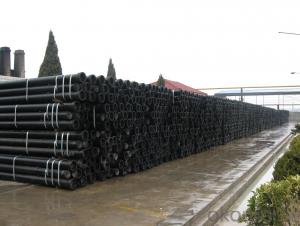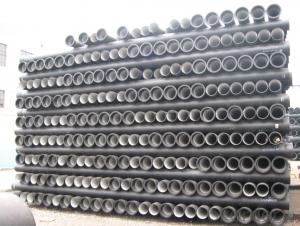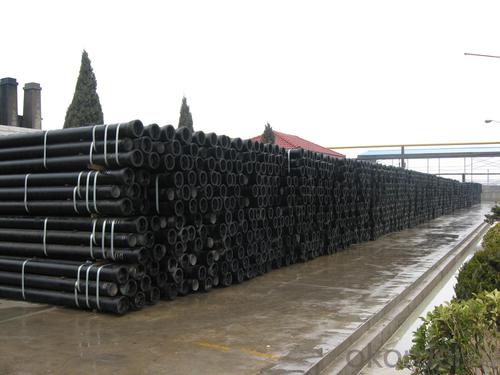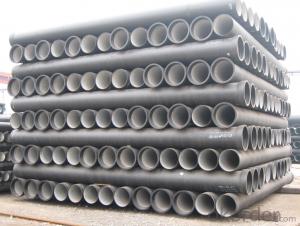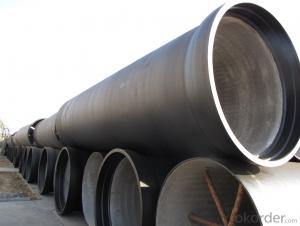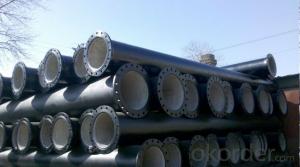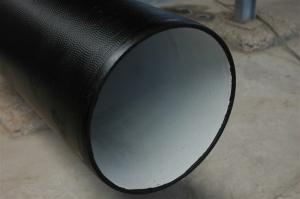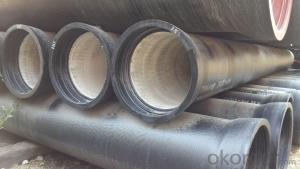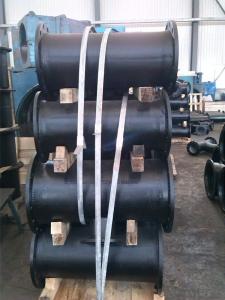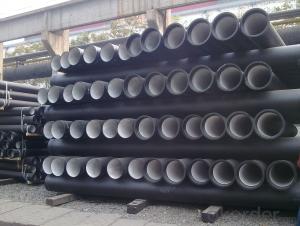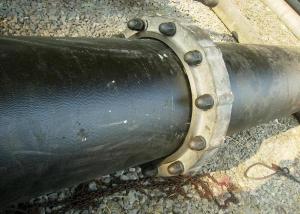Ductile Iron Pipe DN80
- Loading Port:
- Tianjin
- Payment Terms:
- TT or LC
- Min Order Qty:
- 23 m.t.
- Supply Capability:
- -
OKorder Service Pledge
OKorder Financial Service
You Might Also Like
Specifications
Quick Details
| Place of Origin: | China (Mainland) | Brand Name: | CMAX | Model Number: | T type / K type / Flange type |
| Length: | 6m / 5.7m / Negotiable | Standard: | ISO2531 / EN545 / EN598 | Application: | Potable / Sewage water |
| Diameter: | DN80~DN2200 | Shape: | Round | Hardness: | 230 |
| Pipe Wall Thickness: | standard | Pull Strength: | 420 | Yield (≥ MPa): | 300 |
| Material: | Ductile Iron | Type: | Centrifugal ductile cast iron pipe | Certification: | ISO2531 / EN545 / EN598 |
| Outer Diameter: | 80-2200 | Thickness: | standard | Specification: | DN80~DN2200 |
The advantages to the customer:
Trustworthy financial strength.
One-stop shopping.
Fast and efficient service.
Coordination of shipments from multiple plants.
Specialists of the overseas shipping process.
A more competitive price.
Ductile iron pipe is sized according to a dimensionless term known as the Pipe Size or Nominal Diameter (known by its French abbreviation, DN). This is roughly equivalent to the pipe's internal diameter in inches or millimeters. However, it is the external diameter of the pipe that is kept constant between changes in wall thickness, in order to maintain compatibility in joints and fittings. Consequently the internal diameter varies, sometimes significantly, from its nominal size. Nominal pipe sizes vary from 3 inches up to 64 inches, in increments of at least 1 inch, in the USA.
Pipe dimensions are standardised to the mutually incompatible AWWA C151 (U.S. Customary Units) in the USA, ISO 2531 / EN 545/598 (metric) in Europe, and AS/NZS 2280 (metric) in Australia and New Zealand. Although both metric, European and Australian are not compatible and pipes of identical nominal diameters have quite different dimensions.
Flanges are flat rings around the end of pipes which mate with an equivalent flange from another pipe, the two being held together by bolts usually passed through holes drilled through the flanges. A deformable gasket, usually elastomeric, placed between raised faces on the mating flanges provides the seal. Flanges are designed to a large number of specifications that differ because of dimensional variations in pipes sizes and pressure requirements, and because of independent standards development. In the U.S. flanges are either threaded or welded onto the pipe. In the European market flanges are usually welded on to the pipe. In the U.S. flanges are available in a standard 125 lb. bolt pattern as well as a 250 lb (and heavier) bolt pattern (steel bolt pattern). Both are usually rated at 250 psi (1,700 kPa). A flanged joint is rigid and can bear both tension and compression as well as a limited degree of shear and bending. It also can be dismantled after assembly. Due to the rigid nature of the joint and the risk of excessive bending moment being imposed, it is advised that flanged pipework is not buried.
Current flange standards used in the water industry are ANSI B16.1 in the USA, EN 1092 in Europe, and AS/NZS 4087 in Australia and New Zealand.
Ductile iron pipe is somewhat resistant to internal corrosion in potable water and less aggressive forms of sewage. However, even where pipe material loss and consequently pipe wall reduction is slow, the deposition of corrosion products on the internal pipe wall can reduce the effective internal diameter. A variety of linings are available to reduce or eliminate corrosion, including cement mortar, polyurethane and polyethylene. Of these, cement mortar lining is by far the most common.
Polyurethane (Plastic wrap) marginally protects piping made of ductile cast iron against corrosion and ensures meeting hygienic standards for drinking water at the same time in the early years. Polyurethane is used for both the inside lining and the outside coating. Because of polyurethane's elasticity, the coating remains intact even if the pipe is deformed. A major problem is that the poly wrap is not able to be uniformly installed or even installed without rips and creates isolated corrosion attacks. Corrosion Experts
Polyurethane coatings were first used in 1972.[citation needed] In comparison with other coatings, the internal polyurethane lining exhibits a high resistance to various different media such as drinking water, wastewater, de-mineralised water, industrial water and gas, as well as to aggressive solutions such as sulphuric acid. The polyurethane outside coating is suitable for all kinds of soil.
Polyurethane is a thermosetting plastic with no solvents, with a three-dimensionally linked molecular structure giving it mechanical stability. The polyurethane used for conating has the following standard properties, according to EN 545 and ISO 2531 standards.
- Q: Can ductile iron pipe be used for sewer and wastewater systems?
- Yes, ductile iron pipe can be used for sewer and wastewater systems. Ductile iron is a type of cast iron that has improved properties such as increased durability, strength, and flexibility. These qualities make it suitable for underground applications, including sewer and wastewater systems. Ductile iron pipes are resistant to corrosion and can withstand high-pressure conditions, making them ideal for conveying sewage and wastewater. Additionally, ductile iron pipes have a long service life and require minimal maintenance, which makes them a cost-effective choice for sewer and wastewater infrastructure.
- Q: Are ductile iron pipes suitable for installation in areas with high groundwater table?
- Indeed, areas with a high groundwater table are suitable for the installation of ductile iron pipes. These pipes are renowned for their exceptional strength and durability, rendering them perfect for underground installations. They possess the ability to endure the external pressure exerted by groundwater without any deformation or collapse. In addition, their outstanding resistance to corrosion shields them from the potentially harmful impact of groundwater. Consequently, ductile iron pipes can be confidently utilized in areas with a high groundwater table, ensuring the establishment of dependable and enduring water supply infrastructure.
- Q: How are ductile iron pipes connected?
- There are several methods commonly used to connect ductile iron pipes, including flanged joints, mechanical joints, and push-on joints. Flanged joints involve connecting two sections of pipe by using a flanged coupling. The pipe ends have flanges that are securely bolted together, creating a connection that is both strong and leak-proof. This method is often used for pipes with larger diameters or in situations where a rigid joint is necessary. Mechanical joints use a mechanical joint gland and rubber gasket to create a seal that is watertight. The ends of the pipes are inserted into the gland, and then bolts are tightened to compress the gasket, ensuring a reliable connection. This method is frequently employed in water distribution systems because it is flexible and easy to install. Push-on joints utilize a rubber gasket to create a tight seal between sections of pipe. The gasket is placed in a groove on one end of a pipe, and then the other pipe is pushed onto it, resulting in a compression seal. This method is quick and straightforward, making it suitable for a variety of applications, such as sewer systems and underground piping. Ultimately, the choice of connection method for ductile iron pipes depends on factors such as pipe diameter, application requirements, and installation conditions. It is of utmost importance to adhere to the manufacturer's recommendations and industry standards to ensure proper installation and dependable performance.
- Q: What's the advantage of FCD50 ductile iron?
- Ductile cast iron pipes are called ductile iron pipes.
- Q: How do ductile iron pipes handle ground movement or settlement?
- Ductile iron pipes are renowned for their remarkable strength and flexibility, enabling them to effectively manage ground movement or settlement. Ground movement or settlement pertains to the natural shifts or settling of the earth's surface, which can exert stress on subterranean infrastructure such as pipes. Concerning ground movement, ductile iron pipes possess the advantage of enduring and absorbing the pressure and movement caused by shifting soil. The material's ductility permits the pipes to flex and bend to a certain extent without fracturing. This flexibility aids in distributing the load and minimizing the potential for harm. Additionally, ductile iron pipes exhibit high resistance to cracking or fracturing, even under extreme circumstances. This resilience stems from the material's unique microstructure, which imparts excellent tensile strength and impact resistance. Consequently, ductile iron pipes can withstand external forces and ground settlement without compromising their integrity. To further augment their capacity to handle ground movement or settlement, ductile iron pipes are frequently installed using flexible joints. These joints allow for slight movement and accommodate any shifting or settling of the ground. Furthermore, proper bedding and backfilling techniques are employed during installation to provide added support and stability. Overall, ductile iron pipes possess a proven track record in managing ground movement or settlement. Their strength, flexibility, and resistance to cracking establish them as a dependable choice for subterranean infrastructure, ensuring the durability and efficiency of water distribution systems.
- Q: How to correctly measure ductile iron pipe
- The outer diameter of the ball tube is measured around the outer edge of the pipe. The caliper is used to measure the inside diameter of the pipe. The length of the pipe is measured by a ruler or tape measure,
- Q: What are the different methods for restraining ductile iron pipe?
- There are several different methods for restraining ductile iron pipe. These methods are used to prevent movement or displacement of the pipe due to internal pressure, external forces, or ground movement. The most common methods for restraining ductile iron pipe include: 1. Thrust blocks: Thrust blocks are concrete blocks or structures that are placed against the pipe at bends, tees, or other changes in direction. These blocks are designed to resist the forces exerted by the flowing water or other fluids within the pipe, effectively anchoring the pipe in place. 2. Mechanical restraints: Mechanical restraints, such as harnesses or clamps, are devices that are installed around the pipe and attached to a fixed structure, such as a wall or a concrete anchor. These restraints provide a physical barrier that prevents the pipe from moving or shifting. 3. Pipe restraints: Pipe restraints are devices that are directly attached to the pipe and anchored to a fixed structure. These restraints can include pipe clamps, pipe restraints, or pipe saddles. They are designed to securely hold the pipe in place and resist any movement or displacement. 4. Pipe bedding and backfill: Proper pipe bedding and backfilling is important for restraining ductile iron pipe. The pipe must be properly supported and surrounded by compacted material to prevent movement or shifting. This method involves carefully placing and compacting soil or other suitable materials around the pipe to provide stability and prevent displacement. 5. Trench walls: The walls of the trench in which the ductile iron pipe is installed can also provide some level of restraint. By properly compacting the soil against the pipe and ensuring proper compaction and stability of the trench walls, the pipe can be effectively restrained and prevented from movement. Overall, the different methods for restraining ductile iron pipe aim to ensure the pipe remains securely in place and does not experience any displacement or movement. The choice of method depends on factors such as the location, application, and the forces acting on the pipe. It is important to consult with engineers and follow industry guidelines and standards to determine the most appropriate method for restraining ductile iron pipe in specific situations.
- Q: What is the manufacturing process of ductile iron pipes? Thank you
- Pig iron function: pig iron is strong, wear-resisting, good forging, but pig iron is crisp, cannot forge. Most frequently used: ductile iron covers, ductile iron pipes, ductile iron pipe fittings, ductile iron pipes are widely used in our life.
- Q: Can ductile iron pipes be used for underground sewage systems?
- Yes, ductile iron pipes can be used for underground sewage systems. Ductile iron is a type of cast iron that has enhanced flexibility and strength, making it suitable for various applications, including sewage systems. Ductile iron pipes offer several advantages for underground sewage systems. Firstly, they have excellent corrosion resistance, which is crucial in sewage systems where the presence of moisture and chemicals can cause corrosion over time. This resistance to corrosion ensures the long-term durability and reliability of the pipes. Secondly, ductile iron pipes have high tensile strength, allowing them to withstand the pressure and stress that can occur in underground sewage systems. They are resistant to ground movements, such as soil settling or shifting, which can cause damage to other types of pipes. Furthermore, ductile iron pipes have a smooth internal surface, which results in a better flow capacity and reduces the likelihood of clogging or blockages in the sewage system. This smooth surface also helps to minimize the accumulation of debris and sediment, reducing the need for frequent maintenance and cleaning. Another important factor is that ductile iron pipes are available in various sizes and can easily be connected using a range of joint systems, allowing for flexibility in designing and constructing underground sewage systems. In summary, ductile iron pipes are an excellent choice for underground sewage systems due to their corrosion resistance, high tensile strength, smooth internal surface, and ease of installation.
- Q: Can ductile iron pipe be recycled?
- Yes, ductile iron pipe can be recycled. Ductile iron is a type of iron that is commonly used in the manufacturing of pipes due to its high strength and durability. When a ductile iron pipe reaches the end of its useful life, it can be recycled by melting it down and using the molten iron to create new products. Recycling ductile iron pipe not only helps conserve natural resources but also reduces the need for raw materials and energy-intensive processes involved in manufacturing new pipes. Additionally, recycling ductile iron pipe helps minimize waste and contributes to a more sustainable and environmentally friendly approach to infrastructure development.
Send your message to us
Ductile Iron Pipe DN80
- Loading Port:
- Tianjin
- Payment Terms:
- TT or LC
- Min Order Qty:
- 23 m.t.
- Supply Capability:
- -
OKorder Service Pledge
OKorder Financial Service
Similar products
Hot products
Hot Searches
Related keywords
